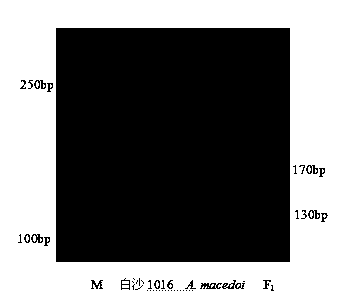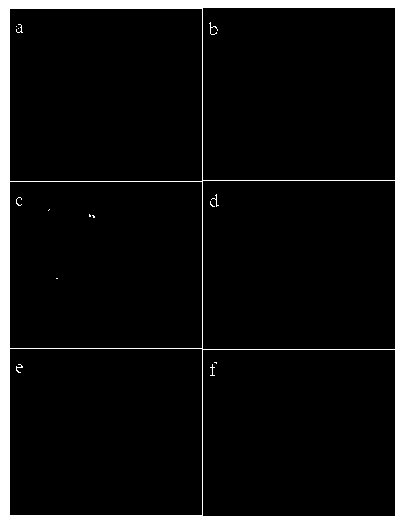Method for obtaining, breeding and storing peanut interspecies hybridization variety, and identifying molecular cytology
A preservation method and peanut seed technology, applied in the fields of botanical equipment and methods, horticultural methods, plant regeneration, etc., can solve the problems of poor chromatin heterogeneity, infertility, inability to continue generations, etc., and overcome incompatibility. Sex, the effect of enriching the genetic basis
- Summary
- Abstract
- Description
- Claims
- Application Information
AI Technical Summary
Problems solved by technology
Method used
Image
Examples
Embodiment 1
[0048] Example 1. Peanut Interspecific Hybrid F 1 method of obtaining
[0049] The cultivated species Baisha 1016 (preserved by the Institute of Economic Crops, Henan Academy of Agricultural Sciences) was used as the female parent, and the wild species A. macedoi F 1 ,Specific steps are as follows:
[0050] (1) Artificial hybridization
[0051] In Baisha 1016 with A. macedoi At the beginning of flowering period, from 16:00 to 18:00 in the afternoon every day, select the calyx micro-cracked flower buds of the female parent, gently poke the petals with tweezers, remove the stamens, and mark the nodes where the stamens are removed; the next day Collect the male parent flower in the morning, take its pollen, apply the pollen on the stigma of the female parent plant where the stamen flower has been removed with tweezers; after routine fertilization, watering, fix the branches after the fruit needles are exposed, harvest after 60-80 days, and observe the hybridization Pods ...
Embodiment 2
[0060] Example 2. Peanut Interspecific Hybrid F 1 The breeding and preservation method, comprises the following steps:
[0061] (1) Take F from the culture medium under the ultra-clean bench 1 For seedlings, cut the seedlings into 2-3 sections, each section retaining at least one leaf, and place the terminal bud section of the seedlings in a solid rooting medium composed of MS, 0.8 mg / L NAA (naphthaleneacetic acid) and 3% sucrose , cultivated for 15-30 days, until a complete plant is obtained;
[0062] (2) Place the other sections of the seedlings in a solid medium consisting of MS, 0.1 mg / L NAA, 0.4 mg / L 6-BA (6-benzyl adenine) and 3% sucrose, and light at a constant temperature of 25°C Induce bud differentiation in the culture room for 15-30 days, then inoculate into solid rooting medium composed of MS, 0.8 mg / L NAA and 3% sucrose, and culture for 15-30 days until a complete plant is formed;
[0063] By repeating the above two steps, the hybrid F can be propagated and p...
Embodiment 3
[0064] Example 3. Peanut distant hybrid F 1 The molecular cytological identification method, the specific steps are as follows:
[0065] (1) Take the female parent Baisha 1016 and the male parent A. macedoi and hybrid F 1 The leaves of the plants were extracted from the female parent, male parent and hybrid F by CTAB method. 1 DNA of the plant;
[0066] (2) Use Baisha 1016 and A. macedoi The specific marker E66 was used for PCR reaction, followed by polyacrylamide gel electrophoresis analysis, the steps are as follows:
[0067] Perform PCR reaction first: PCR reaction volume is 10 μl, including template genomic DNA 0.9 μl (25 ng / ml), SSR primer (R) 0.2 μl (10 μM), SSR primer (F) 0.2 μl (10 μM), 10 ×buffer 1μl, dNTP (2.5 mM) 0.9 μl, MgCl 2 (25 mM) 0.8 μl, Taqase 0.1 μl (0.5U), ddH2 O 5.9 μl. Mix the above ingredients and centrifuge, add a drop of paraffin oil to cover to prevent water from evaporating;
[0068] Then carry out PCR amplification: the reaction is carri...
PUM
 Login to View More
Login to View More Abstract
Description
Claims
Application Information
 Login to View More
Login to View More - R&D
- Intellectual Property
- Life Sciences
- Materials
- Tech Scout
- Unparalleled Data Quality
- Higher Quality Content
- 60% Fewer Hallucinations
Browse by: Latest US Patents, China's latest patents, Technical Efficacy Thesaurus, Application Domain, Technology Topic, Popular Technical Reports.
© 2025 PatSnap. All rights reserved.Legal|Privacy policy|Modern Slavery Act Transparency Statement|Sitemap|About US| Contact US: help@patsnap.com



